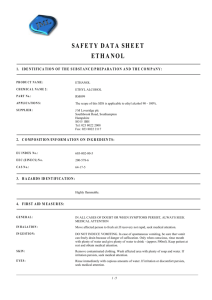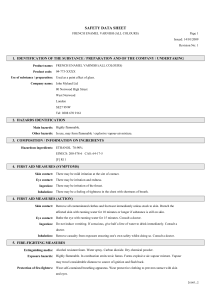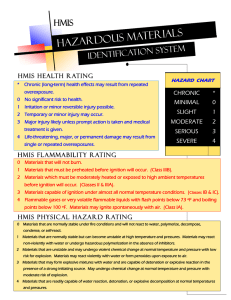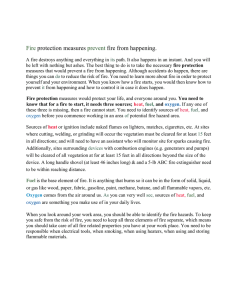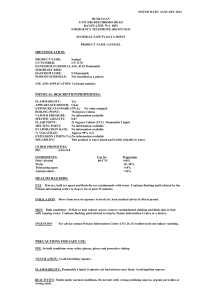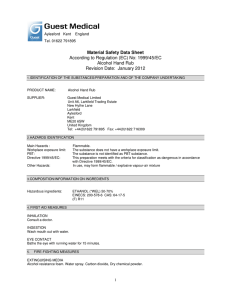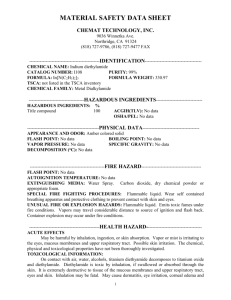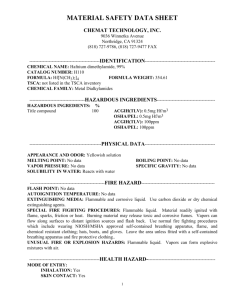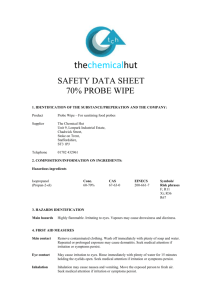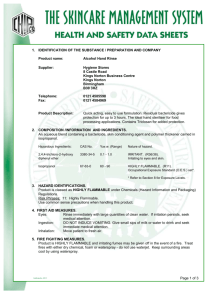Perfumer's Alcohol MSDS | Safety Data Sheet
advertisement
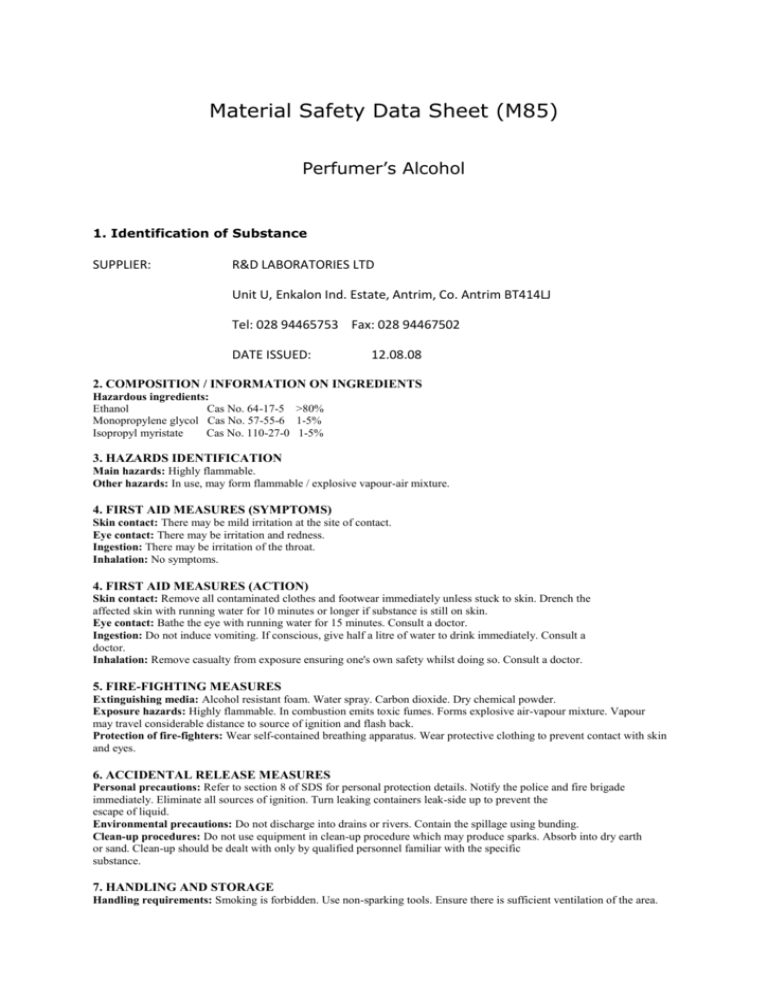
Material Safety Data Sheet (M85) Perfumer’s Alcohol 1. Identification of Substance SUPPLIER: R&D LABORATORIES LTD Unit U, Enkalon Ind. Estate, Antrim, Co. Antrim BT414LJ Tel: 028 94465753 Fax: 028 94467502 DATE ISSUED: 12.08.08 2. COMPOSITION / INFORMATION ON INGREDIENTS Hazardous ingredients: Ethanol Cas No. 64-17-5 >80% Monopropylene glycol Cas No. 57-55-6 1-5% Isopropyl myristate Cas No. 110-27-0 1-5% 3. HAZARDS IDENTIFICATION Main hazards: Highly flammable. Other hazards: In use, may form flammable / explosive vapour-air mixture. 4. FIRST AID MEASURES (SYMPTOMS) Skin contact: There may be mild irritation at the site of contact. Eye contact: There may be irritation and redness. Ingestion: There may be irritation of the throat. Inhalation: No symptoms. 4. FIRST AID MEASURES (ACTION) Skin contact: Remove all contaminated clothes and footwear immediately unless stuck to skin. Drench the affected skin with running water for 10 minutes or longer if substance is still on skin. Eye contact: Bathe the eye with running water for 15 minutes. Consult a doctor. Ingestion: Do not induce vomiting. If conscious, give half a litre of water to drink immediately. Consult a doctor. Inhalation: Remove casualty from exposure ensuring one's own safety whilst doing so. Consult a doctor. 5. FIRE-FIGHTING MEASURES Extinguishing media: Alcohol resistant foam. Water spray. Carbon dioxide. Dry chemical powder. Exposure hazards: Highly flammable. In combustion emits toxic fumes. Forms explosive air-vapour mixture. Vapour may travel considerable distance to source of ignition and flash back. Protection of fire-fighters: Wear self-contained breathing apparatus. Wear protective clothing to prevent contact with skin and eyes. 6. ACCIDENTAL RELEASE MEASURES Personal precautions: Refer to section 8 of SDS for personal protection details. Notify the police and fire brigade immediately. Eliminate all sources of ignition. Turn leaking containers leak-side up to prevent the escape of liquid. Environmental precautions: Do not discharge into drains or rivers. Contain the spillage using bunding. Clean-up procedures: Do not use equipment in clean-up procedure which may produce sparks. Absorb into dry earth or sand. Clean-up should be dealt with only by qualified personnel familiar with the specific substance. 7. HANDLING AND STORAGE Handling requirements: Smoking is forbidden. Use non-sparking tools. Ensure there is sufficient ventilation of the area. Do not handle in a confined space. Avoid the formation or spread of mists in the air. Storage conditions: Store in cool, well ventilated area. Keep container tightly closed. Keep away from sources of ignition. Prevent the build up of electrostatic charge in the immediate area. Ensure lighting and electrical equipment are not a source of ignition. 8. EXPOSURE CONTROLS / PERSONAL PROTECTION Occupational exposure limits TWA (8 hr exposure limit): 1920 mg/m3 (OES) Engineering measures: Ensure there is sufficient ventilation of the area. Ensure lighting and electrical equipment are not a source of ignition. Respiratory protection: Respiratory protection not required. Hand protection: Protective gloves. Eye protection: Safety glasses. Ensure eye bath is to hand. Skin protection: Protective clothing. 9. PHYSICAL AND CHEMICAL PROPERTIES State: Liquid Flash point°C: 15 10. STABILITY AND REACTIVITY Stability: Stable under normal conditions. Stable at room temperature. Conditions to avoid: Heat. Hot surfaces. Sources of ignition. Flames. Materials to avoid: Strong oxidising agents. Strong acids. Haz. decomp. products: In combustion emits toxic fumes. 11. TOXICOLOGICAL INFORMATION Routes of exposure: Refer to section 4 of SDS for routes of exposure and corresponding symptoms. 12. ECOLOGICAL INFORMATION Mobility: Readily absorbed into soil. Persistence and degradability: Biodegradable. Bioaccumulative potential: No bioaccumulation potential. Other adverse effects: Negligible ecotoxicity. 13. DISPOSAL CONSIDERATIONS NB: The user's attention is drawn to the possible existence of regional or national regulations regarding disposal. 14. TRANSPORT INFORMATION ADR / RID UN no: 1170 ADR Class: 3 Packing group: II Classification code: F1 Shipping name: ETHANOL (ETHYL ALCOHOL) Labelling: 3 Hazard ID no: 33 IMDG / IMO UN no: 1170 Class: 3 Packing group: II EmS: F-E,S-D Marine pollutant: NO Labelling: 3 IATA / ICAO UN no: 1170 Class: 3 Packing group: II Packing instructions: 305(P&CA); 307(CAO) Labelling: 3 15. REGULATORY INFORMATION Hazard symbols: Highly flammable. Risk phrases: R11: Highly flammable. Safety phrases: S9: Keep container in a well-ventilated place. S36: Wear suitable protective clothing. S16: Keep away from sources of ignition - No smoking. S33: Take precautionary measures against static discharges. S60: This material and its container must be disposed of as hazardous waste. Note: The regulatory information given above only indicates the principal regulations specifically applicable to the product described in the safety data sheet. The user's attention is drawn to the possible existence of additional provisions which complete these regulations. Refer to all applicable national, international and local regulations or provisions. 16. OTHER INFORMATION

